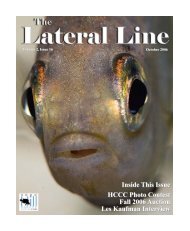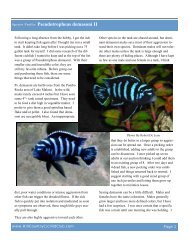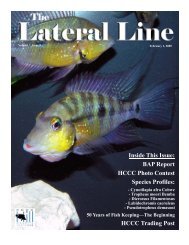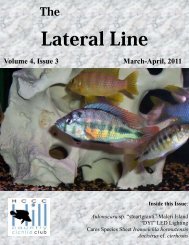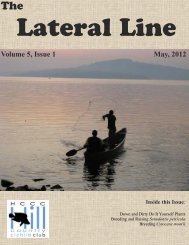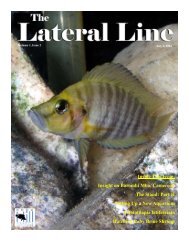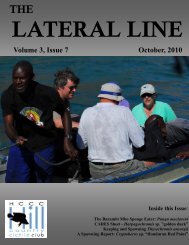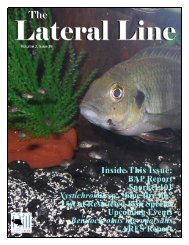Lateral Line December 2011 - Hill Country Cichlid Club
Lateral Line December 2011 - Hill Country Cichlid Club
Lateral Line December 2011 - Hill Country Cichlid Club
You also want an ePaper? Increase the reach of your titles
YUMPU automatically turns print PDFs into web optimized ePapers that Google loves.
6<br />
Aulonocranus dewindti “Zambia”: A Spawning Report<br />
- Benjamin L. Smith<br />
A beautiful male Aulonocranus dewindti in the author’s aquarium.<br />
Aulonocranus dewindti is a cichlid of Lake<br />
Tanganyika found in the intermediate habitat<br />
1 . It fits the bill of both a sand sifter as<br />
well as a featherfin. Like most other<br />
featherfins, the males display lustrous colors<br />
when courting which they can turn off and<br />
on like a light. Unlike Cyathopharynx, they<br />
will tend to carry at least some color all of<br />
the time making it easy to differentiate the<br />
males from females in adult populations.<br />
The tips of the ventral fins have a hint of<br />
yellow, however they do not have the lappets<br />
that the Ophthalmotilapia ventralis and<br />
Ophthalmotilapia nasuta use as egg dummies.<br />
The variant I kept was from Dave's<br />
Rare Aquarium Fish and sported horizontal<br />
blue and yellow stripes. In Ad Konings'<br />
books, there are images of a fish from<br />
Mabilibili that appear to have a dark copper<br />
base with blue stripes and are quite stunning<br />
2 .<br />
The waters the fish hails from is like that of<br />
most of the lake in that it is alkaline and<br />
hard. The tap water at my home is the same<br />
so no adjustments are necessary other than<br />
dechlorinator. The temperatures range in the<br />
upper 70 O F in the lake and the tank temperatures<br />
at my home range from 73-75 O F.<br />
The slightly lower temperature doesn't seem<br />
to affect spawning frequency, though I have<br />
noted that in the tanks which I heat to 78 O F,<br />
the time for the fry to become free swimming<br />
drops from 3 weeks to 2 weeks.<br />
In the wild, the fish sifts sand searching for<br />
invertebrates. In my tank they were fed a<br />
staple diet flake. The fry were initially fed



